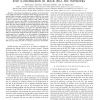Free Online Productivity Tools
i2Speak
i2Symbol
i2OCR
iTex2Img
iWeb2Print
iWeb2Shot
i2Type
iPdf2Split
iPdf2Merge
i2Bopomofo
i2Arabic
i2Style
i2Image
i2PDF
iLatex2Rtf
Sci2ools
GLOBECOM
2008
IEEE
2008
IEEE
Network Formation Games for Distributed Uplink Tree Construction in IEEE 802.16J Networks
— This paper investigates the problem of the formation of an uplink tree structure among the IEEE 802.16j network’s relay stations (RSs) and their serving base station (MR-BS). We model the problem as a network formation game in which the RSs want to form a directed tree graph to improve their utility, in terms of the packet success rate (PSR), by using multi-hop cooperative transmission while accounting for a link maintenance cost. In this game, the relay stations engage in bilateral negotiations which result in a contractual agreement to form a directed link between each pair. For network dynamics, we propose an algorithm based on the local best responses of the RSs that converges to a local Nash network. Moreover, the proposed dynamics algorithm allows the RSs to autonomously adapt the network topology to changes in the environment due to mobility or to the presence of heterogeneous traffic. Simulation results show how the RSs can self-organize in a tree structure while improvi...
| Added | 29 May 2010 |
| Updated | 29 May 2010 |
| Type | Conference |
| Year | 2008 |
| Where | GLOBECOM |
| Authors | Walid Saad, Zhu Han, Mérouane Debbah, Are Hjørungnes |
Comments (0)

